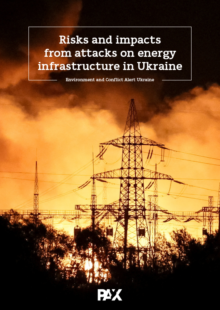Risks and impacts from attacks on energy infrastructure in Ukraine
December 21, 2022
Environment and Conflict Alert Ukraine
Download 7.41 MB
Winter, cold and harsh, has arrived in Ukraine. Russia has accordingly stepped up its attempts to inflict suffering on the Ukrainian population by targeting energy infrastructure across the country. Dozens of strikes against power plants and substations have had serious impacts on access to heating, drinking water, sewage facilities and power in general, including for military, governmental and industrial purposes. These deliberate strikes have worsened the humanitarian situations for millions of Ukrainian civilians, risking wider long-term environmental challenges and potentially posing serious transboundary risks of pollution and even nuclear fallout.
To determine the magnitude and impacts of these attacks, PAX monitored open-source reporting in conjunction with high-resolution satellite imagery for verification and damage identification. This is part of a broader effort on environmental data collection in relation to the war in Ukraine that should help build accountability and support rapid assessment and remediation efforts.
In the period February – November 2022, PAX identified 213 reported incidents from military actions on energy infrastructure, 63 of which were verified. The largest attacks on Ukrainian energy infrastructure were launched by Russian forces in October 2022. The October attacks damaged 40% of Ukraine’s electricity generation and transmission facilities, causing temporary blackouts in most of the country as well as creating both environmental risks and a humanitarian crisis, leaving millions of Ukrainian civilians without electricity, heating and water.





